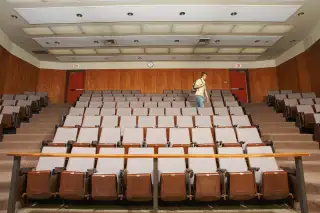What's Really Wrong With College Today?

Pity the poor souls sending their sons and daughters off to college next fall. A chorus of commentators are eager to tell them that tuition in public higher education is “skyrocketing” because profligate college administrators are adding recklessly to their bloated staffs, or that the economy is awash in unemployed college graduates to a point where degrees no longer pay. And even if a lucky graduate nails down a job, some claim, all of her earnings will go to whittling down that mountain of debt that has been piled on her.
The good news about college is that none of these hyperbolic statements is true, or even close to it. The bad news is that the atmosphere of crisis bred by these wild assertions distracts us from the very real and quite serious problems besetting American higher education.
A central aim of our new book, Lesson Plan, is to help change the focus to the real issues while clearing away the confusion provoked by exaggerated claims like those above and by utopian—and in fact undesirable—solutions like eliminating student debt, making college free, or replacing most of our undergraduate teaching with purely online learning.
So, in brief:
Public tuition has risen mainly because state governments, hard pressed for funds, have not been able or willing to free enough money to keep up with rapidly expanding enrollments. Tuition charges have risen to make up the difference.
Meanwhile, there has been no increase over the last decade in the size of non-faculty staff, once you correct for those growing enrollments.
What's more, the average “earnings premium,” the gap between the earnings of high school and college graduates, has never been higher than in recent years, and as bad as unemployment was for all groups during the Great Recession, it has always been roughly twice as high for people with no higher education than for those with BAs.
And, finally, most people who earn a BA borrow moderately. In fact, 40% of those earning degrees from public institutions don’t borrow for college at all. Especially with the federal government now providing a range of more flexible loan repayment options, the vast majority of four-year college graduates repay without excessive difficulty.
In all these cases, the real problems lie elsewhere. The shortfalls in state funding that are the real source of rising public tuition are very likely to persist, and they imply that state-run institutions will need to focus patiently and persistently not on chasing largely mythical “administrative bloat,” but on delivering excellent education more effectively and cheaply. In many cases, this will include using digital technologies—not for the wholesale replacement of human instructors, but to extend and support professors’ work through “hybrid” courses that blend human and computer-based teaching.
The big problems with earnings and with debt repayment lie not with four-year college graduates, but rather with the all-too-many students who drop out with no credential (and, we suspect, little learning).
The typical pattern is one of students borrowing relatively little, because they drop out quickly, but having nothing to show for it. Discouraged and with poor job prospects, they fall quickly into trouble with their debt and have serious problems digging out. Loan defaults are about three times more common among drop-outs than among completers.
It is important to add that drop-out problems are more common among students from less advantaged populations and especially at the broad-access institutions most of these students attend. Finding ways to make these institutions more effective for the populations they serve needs to be a top priority if the nation is serious about equalizing opportunity.
What’s the bottom line? First, for parents and students, don’t let the scare stories frighten you away from college. While today’s economy doesn’t offer anyone a guaranteed future, a high quality postsecondary program that won’t load you up with unreasonable debt is a smart way to invest in your future—and we don’t mean only in narrow financial terms. But search out a place with a good graduation record for people like you and if at all possible try to go full time, even if that means taking on some debt.
And for public policy? We don’t have a crisis in higher education, at least not the crisis we read about in the headlines every day. But we do have serious problems, and they are not problems that will be solved by a magic bullet like free college, eliminating student debt, or putting the existing higher education system out of business with technology. The problems we do have are of a kind that a resilient higher education system with strong leadership and with consistent, supportive, and realistic governmental support can set about solving.
Let’s keep calm and carry on.
William G. Bowen is president emeritus of the Andrew W. Mellon Foundation and Princeton University and founding chairman of ITHAKA. His books include The Shape of the River: Long-Term Consequences of Considering Race in College and University Admissions, coauthored with Derek Bok (Princeton University Press).
Michael S. McPherson is president of the Spencer Foundation and former president of Macalester College. His books include Crossing the Finish Line: Completing College at America's Public Universities, coauthored with William G. Bowen and Matthew M. Chingos (Princeton University Press).